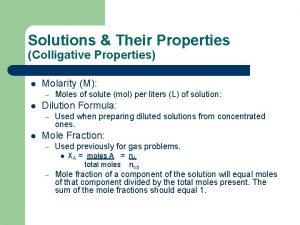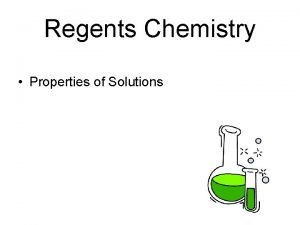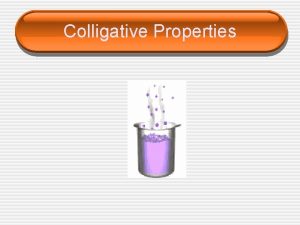Solutions I II III Colligative Properties A Definition










- Slides: 10

Solutions I II III. Colligative Properties

A. Definition u Colligative Property • property that depends on the concentration of solute particles, not their identity

B. Types Freezing Point Depression View Flash animation.

B. Types u Freezing Point Depression ( tf) • f. p. of a solution is lower than f. p. of the pure solvent u Boiling Point Elevation ( tb) • b. p. of a solution is higher than b. p. of the pure solvent

B. Types Boiling Point Elevation Solute particles weaken IMF in the solvent.

B. Types u Applications • salting icy roads • making ice cream • antifreeze • cars (-64°C to 136°C) • fish & insects

C. Calculations t = k · m · n t: change in temperature (°C) k: constant based on the solvent (°C/m) on page 438 in orange MC, 448 in blue MC m: molality (m) n: # of particles

C. Calculations u # of Particles • Nonelectrolytes (covalent) • remain intact when dissolved • 1 particle, so n = 1 always • Electrolytes (ionic) • dissociate into ions when dissolved • 2 or more particles, so n is always greater than 2

C. Calculations u At what temperature will a solution that is composed of 0. 73 moles of glucose in 225 g of phenol boil? (1000 g = 1 kg) GIVEN: b. p. = ? tb = ? kb = 3. 60°C/m m = 3. 2 m n=1 tb = kb · m · n WORK: m = 0. 73 mol ÷ 0. 225 kg tb = (3. 60°C/m )(3. 2 m)(1) tb = 12°C b. p. = 181. 8°C + 12°C b. p. = 194°C

C. Calculations u Find the freezing point of a saturated solution of Na. Cl containing 28 g Na. Cl in 100. m. L water. GIVEN: f. p. = ? tf = ? kf = 1. 86°C/m WORK: (convert g Na. Cl to moles first) m = 0. 48 mol ÷ 0. 100 kg tf = (1. 86°C/m)(4. 8 m)(2) m = 4. 8 m n=2 tf = kf · m · n f. p. = 0. 00°C - 18°C tf = 18°C f. p. = -18°C
 Ions in aqueous solutions and colligative properties
Ions in aqueous solutions and colligative properties Which solution
Which solution Colligative properties definition
Colligative properties definition Colligative property definition
Colligative property definition Propriété colligative
Propriété colligative 4 colligative properties
4 colligative properties Is molarity a colligative property
Is molarity a colligative property Solutions chemistry regents questions
Solutions chemistry regents questions Colligative properties of milk
Colligative properties of milk Colligative properties of solution examples
Colligative properties of solution examples Colligative properties worksheet
Colligative properties worksheet



















